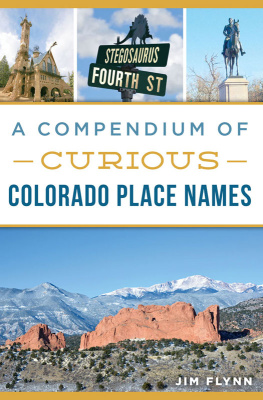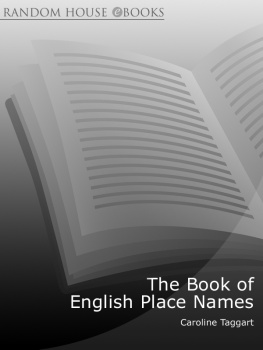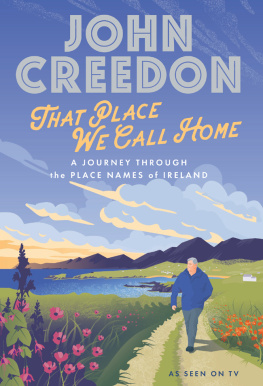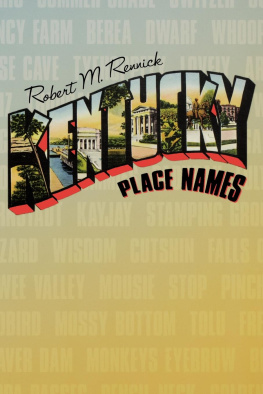

Published by The History Press
Charleston, SC
www.historypress.net
Copyright 2016 by Jim Flynn
All rights reserved
Front cover image of Bishops Castle courtesy of Wikimedia Commons.
First published 2016
e-book edition 2016
ISBN 978.1.43965.873.4
Library of Congress Control Number: 2016947528
print edition ISBN 978.1.46713.732.4
Notice: The information in this book is true and complete to the best of our knowledge. It is offered without guarantee on the part of the author or The History Press. The author and The History Press disclaim all liability in connection with the use of this book.
All rights reserved. No part of this book may be reproduced or transmitted in any form whatsoever without prior written permission from the publisher except in the case of brief quotations embodied in critical articles and reviews.
This book is dedicated to my parents, who taught me to respect the past and challenge the future. May they rest in peace.
CONTENTS
PREFACE
As I was driving into the Colorado high country not long ago in pursuit of late season/hungry/throw-caution-to-the-wind trout, it occurred to me that although I had lived in this beautiful state more than forty years, I knew very little about the origin of its place names. I decided it was time to remedy that situation, and I began tracking down information about these names.
I quickly discovered that every name came with a story, and those stories were interesting and entertaining. Taken together, they told much of the history of Colorado. I also quickly discovered I wasnt the only longtime Colorado resident (to say nothing of visitors to our state) who knew little about this states place names and where they came from. By way of example, in the course of writing this book, after many inquiries, I never found anyone who knew how Denver got its name. Additionally, Siri, although polite and apologetic, was of only occasional help.
Initially, my thought was to put the information I had gathered into something like a travel guidejust an alphabetical list of names with a snippet of name origin information attached to each. But the good folks at The History Press, the publisher of this book, had a better ideaorganize the material into chapters grouping names together that had a common source of inspiration, like Native Americans, explorers, geologic and geographic landmarks and so on, and include brief background material for each of these organizational categories. So, thats what I have done. (If youre looking for a particular name, the index at the end of the book will take you there.)
You wont, of course, find all Colorado names here. There are too many. Ive focused on names that have piqued my curiosity like, say, Slumgullion, or that come with an unusual story attached like, say, Breckenridge. Most names with an obvious derivationeagle, beaver, coyote, Washington, Lincoln, Kennedy, Reagan, Harvard, Yale, Democrat, Republican, Elway, Manning, Helton and so onhave largely been excluded.
I also need to add that this book is not, for the most part, a work of original scholarship. Rather, I have relied on information gathered by others, and some of what you find here may be as much legend as fact. But the legends, if thats what they are, are intriguing.
I would be remiss in not recognizing the digging and sifting accomplishments of others who have worked diligently to uncover the origin of Colorado place names, notably George R. Eichler and his successor, William Bright, who carried on Eichlers scholarship after his death (Colorado Place Names, third edition, Johnson Books, Boulder), as well as Maxine Benson, who added to the list of names addressed by Eichler and Bright and sometimes found competing theories of name origin (1001 Colorado Place Names, University Press of Kansas). Im also indebted to Carl Abbott, Steven J. Leonard and Thomas J. Noel, authors of Colorado: A History of the Centennial State, fifth edition (University Press of Colorado). This book helped me understand what was happening in Colorado during the times most of the place names referenced in my book were being created.
If you find a name that isnt in this book and you think it should be (and you know where the name came from), let me know and Ill include it in the next edition.
INTRODUCTION
As you would expect, Colorado place names come from a multitude of sources. This includes the Spanish empire and its North American successor, Mexico, and their fondness for saints and other religious references. It includes Native Americans, who can trace their roots back many thousands of years to the days of wooly mammoths and primitive tools and who had most of Colorado to themselves until the 1800s. But then the great European-American western migration began, and Native American populations were decimated by warfare, white mans diseases, shrinking animal herds due to overhunting and, some would argue, genocide.
Also in the mix of place name originators are the explorers who endured incredible hardship and danger to explore and map what is now Colorado and to climb its highest mountains on their day off. (All of this took place before REI and Gore-Tex.) North American mountain men are part of this group, although their objective was not so much to explore and map as it was to kill beavers and send their pelts back to Europe, where beaver hats were held in high esteem as a mens fashion item. If it hadnt been for a change in European fashion preference from beaver hats to silk hats, the beaver population in Colorado might have been exterminated. These poor crittersbusy building dams, lodges and ponds and paying no attention to their safetydidnt seem to realize that they were on their way to regional extinction. Soldiers also belong in this group since their military assignments often included exploration. In addition, a substantial military presence was necessary in Colorado during its formative years to support the western European-American migration, and a substantial military presence has continued ever since, now to protect against (or be prepared to engage in) space and cyber warfare.
Then we have the prospectors, lured to Colorado by an 1859 gold rush, a silver boom in the 1870s, another gold rush in the 1890s and a realization that coal and other mineral deposits in Colorado could be exploited for profit. Although Colorado wasand continues to befamous for refining the concept of boom and bust, prospectors and miners were the most prolific at this enterprise. After the 1859 gold rush flamed out, there were as many people trudging across the Great American Desert from west to east as there were from east to west.
Next we have the railroads. Despite the immense capital needed to build a rail line, there were dozens of railroad companies trying to lay tracks and gain shipping monopolies throughout the Colorado Territory (and, starting in 1876, the state of Colorado). Most went broke, but a few survived. The competition was fierce, including at one point armed conflict between two railroad companies vying to establish a rail line from Pueblo to Leadville along the Arkansas River. Until the arrival of rail service, reaching Colorado from take-off points along the Missouri River corridor required a miserable multi-day/multi-week stagecoach or ox cart trip across the prairies. In addition to wholly uncomfortable transportation devices (shock absorber technology was in its infancy), travelers had to endure blizzards, dust storms, rain, hail, tornados, rattlesnakes, swarming insects, bandits and hostile Indians if they wanted to get to Colorado. Railroads changed all that and made the journey to Colorado almost pleasant (probably more so than todays air travel). The railroads established new towns along their routes and gave them names, with the names, in most cases, lasting far longer than the railroads.
Next page









